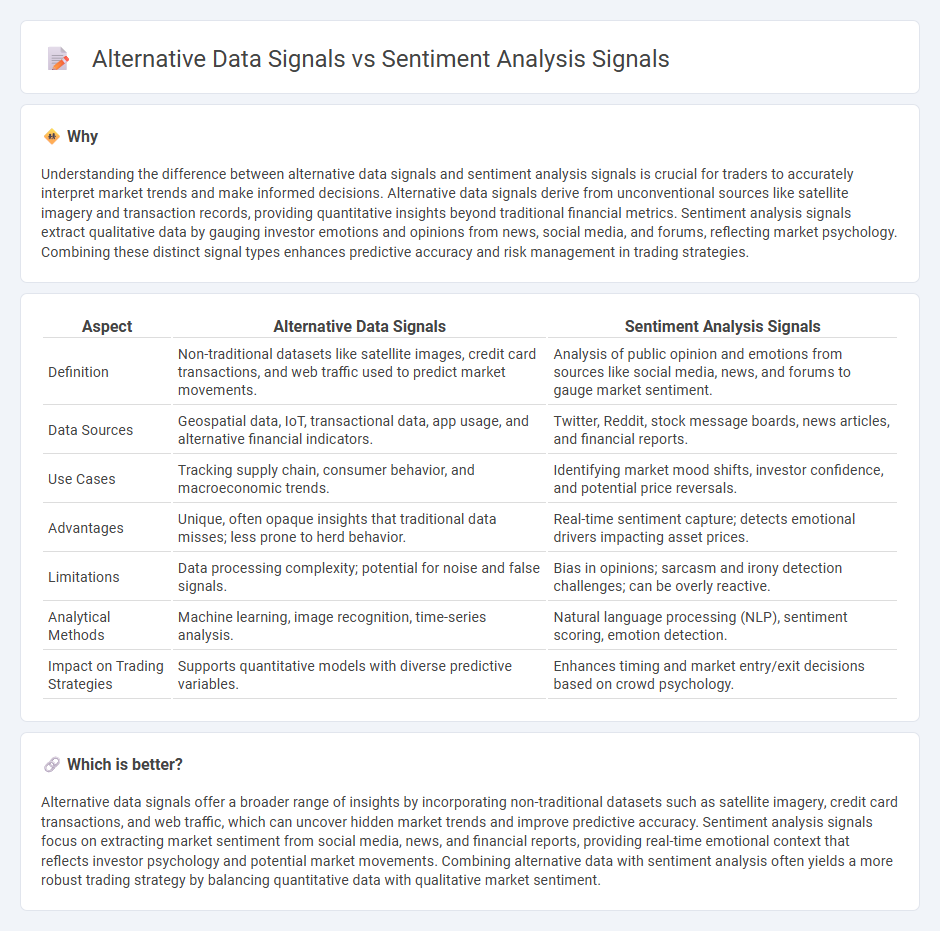
Alternative data signals in trading encompass unconventional sources such as satellite images, transaction data, and web traffic to predict market movements with unique insights. Sentiment analysis signals focus on extracting trader and consumer emotions from social media, news, and forums to gauge market confidence and potential price shifts. Explore how combining these powerful approaches can enhance your trading strategy and decision-making.
Why it is important
Understanding the difference between alternative data signals and sentiment analysis signals is crucial for traders to accurately interpret market trends and make informed decisions. Alternative data signals derive from unconventional sources like satellite imagery and transaction records, providing quantitative insights beyond traditional financial metrics. Sentiment analysis signals extract qualitative data by gauging investor emotions and opinions from news, social media, and forums, reflecting market psychology. Combining these distinct signal types enhances predictive accuracy and risk management in trading strategies.
Comparison Table
| Aspect | Alternative Data Signals | Sentiment Analysis Signals |
|---|---|---|
| Definition | Non-traditional datasets like satellite images, credit card transactions, and web traffic used to predict market movements. | Analysis of public opinion and emotions from sources like social media, news, and forums to gauge market sentiment. |
| Data Sources | Geospatial data, IoT, transactional data, app usage, and alternative financial indicators. | Twitter, Reddit, stock message boards, news articles, and financial reports. |
| Use Cases | Tracking supply chain, consumer behavior, and macroeconomic trends. | Identifying market mood shifts, investor confidence, and potential price reversals. |
| Advantages | Unique, often opaque insights that traditional data misses; less prone to herd behavior. | Real-time sentiment capture; detects emotional drivers impacting asset prices. |
| Limitations | Data processing complexity; potential for noise and false signals. | Bias in opinions; sarcasm and irony detection challenges; can be overly reactive. |
| Analytical Methods | Machine learning, image recognition, time-series analysis. | Natural language processing (NLP), sentiment scoring, emotion detection. |
| Impact on Trading Strategies | Supports quantitative models with diverse predictive variables. | Enhances timing and market entry/exit decisions based on crowd psychology. |
Which is better?
Alternative data signals offer a broader range of insights by incorporating non-traditional datasets such as satellite imagery, credit card transactions, and web traffic, which can uncover hidden market trends and improve predictive accuracy. Sentiment analysis signals focus on extracting market sentiment from social media, news, and financial reports, providing real-time emotional context that reflects investor psychology and potential market movements. Combining alternative data with sentiment analysis often yields a more robust trading strategy by balancing quantitative data with qualitative market sentiment.
Connection
Alternative data signals and sentiment analysis signals are interconnected by providing complementary insights for trading decisions. Alternative data, including social media trends, news articles, and consumer behavior, enriches traditional market data with non-financial indicators, while sentiment analysis processes this data to gauge market moods and investor emotions. Together, they enhance predictive models and improve the accuracy of trading algorithms by capturing real-time market sentiment shifts and unconventional market drivers.
Key Terms
Market Emotion Index (Sentiment analysis signals)
Sentiment analysis signals, such as the Market Emotion Index, leverage natural language processing to quantify investor emotions by analyzing news articles, social media, and financial reports, providing real-time insights into market psychology. Alternative data signals encompass diverse datasets like satellite imagery, credit card transactions, and web traffic patterns, offering unique, non-traditional market indicators beyond textual sentiment. Explore how integrating the Market Emotion Index with alternative data can enhance predictive accuracy and investment strategies.
Satellite Imagery (Alternative data signals)
Satellite imagery offers unparalleled insights into economic activity by capturing real-time data on inventory levels, crop health, and industrial operations, enabling precise forecasting beyond traditional sentiment analysis signals derived from news and social media. This alternative data source provides objective, quantifiable metrics that mitigate biases and latency often associated with sentiment-based indicators, enhancing investment decision-making and risk assessment. Explore how integrating satellite imagery with other alternative data signals transforms analytical models for superior market intelligence.
Social Media Mentions Volume (Sentiment analysis signals)
Social Media Mentions Volume represents a key sentiment analysis signal that quantifies the frequency of brand or product mentions across platforms, offering real-time insights into public opinion trends. These signals provide valuable data points that can be analyzed for sentiment polarity and intensity, outperforming many traditional alternative data sources in speed and granularity. Explore the impact of Social Media Mentions Volume on market predictions and consumer behavior for a deeper understanding.
Source and External Links
Sentiment Analysis: Definition, Importance, Indicator Types - Sentiment analysis offers predictive signals about market trends by quantifying emotions and behavioral patterns from sources like surveys, news, and social media to forecast potential trend reversals and investor psychology shifts.
Customer Sentiment Analysis: Beyond Feedback to Behavior - Sentiment analysis uses AI/NLP to derive emotional context not only from text but also from behavioral signals such as frustration or repeated clicks, providing deeper insights into customer experience and decision drivers.
A complete guide to Sentiment Analysis approaches with AI - This process applies AI and text analytics to assign sentiment polarity scores (e.g., from -100 to 100) that quantify positive, negative, or neutral tones, enabling nuanced interpretation of emotions in written language for business or research purposes.
 dowidth.com
dowidth.com